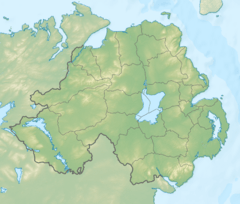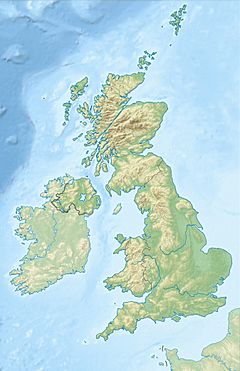Portbraddon Cave facts for kids
| Location | Portbraddon, County Antrim |
|---|---|
| Region | Northern Ireland |
| Coordinates | 55°14′54″N 6°28′32″W / 55.24833°N 6.47556°W |
| Type | sea cave |
| History | |
| Periods | Mesolithic |
| Site notes | |
| Excavation dates | 1930s |
| Archaeologists | Andrew McLean May |
Portbraddon Cave (also known as Portbradden or Portbraddan) is an old sea cave found near Portbraddon, in County Antrim, on the northern coast of Northern Ireland. It's special because it sits about 5 meters (16 feet) above the current sea level. This high position means people could have lived in it a very long time ago, even during the Mesolithic period.
The Mesolithic period was a time when people used stone tools and hunted for food. Because of its age and location, Portbraddon Cave is very important for archaeology. Archaeology is the study of human history through digging up old things.
Discovering Portbraddon Cave's Past
In the 1930s, an archaeologist named Andrew McLean May led an important dig at Portbraddon Cave. He wanted to find out what secrets the cave held about ancient life. His team dug down about 2 meters (6.5 feet) below the modern floor.
What Andrew May Found
During his excavations, Andrew May found many interesting objects. These discoveries helped scientists understand who lived in the cave and how they lived.
- Metal objects: He found some iron items, including part of an old muzzle-loading pistol.
- Pottery and tools: May also discovered pieces of pottery and flint tools. Some of these tools looked like they were from the Mesolithic period. This suggests the cave was used by very early humans.
- Signs of daily life: The team found old fireplaces, which means people cooked and kept warm there. They also found animal bones, showing what animals people hunted and ate.
- The cave's original floor: Eventually, they reached the very bottom of the cave, which was a smooth, water-worn rock surface. This was the cave's floor from when it was first formed by the sea.
The Mystery of the Human Bones
One of the most exciting finds was the partial bones of three human females. These bones were studied by Professor Thomas Walmsley at Queen's University Belfast. He noticed that many of the bones had "primitive features." This means they looked very old and different from bones found in more recent times. He thought they might be from a very ancient period, possibly even before the Mesolithic.
However, the exact location of these human bones is now unknown. This means scientists today cannot use modern methods like radiocarbon dating to find out their exact age. Radiocarbon dating is a scientific way to tell how old something is by measuring carbon in it. If the bones were found, they could tell us much more about the earliest people in Northern Ireland.



